|
Date: 07/24/2023
Topics in This Issue:
-
Refugee Donations
-
Housing Affordability
-
Tucson Plastic Program
-
New Tenants at the Zoo
-
Parks Upgrades
-
Tucson Water
-
Sustainable Tucson – Resilient Neighborhoods
I was in the Walgreen’s next to our office last Friday and bumped into my friend – former team physician for the UA Don Porter. Both he and I were wearing masks. I don’t know if Don had a medical issue he was using the mask to protect the public from or if he was just being cautious for his own benefit. I often wear mine when in stores where the crowds might force close contact – as a precaution, and as a courtesy to others.
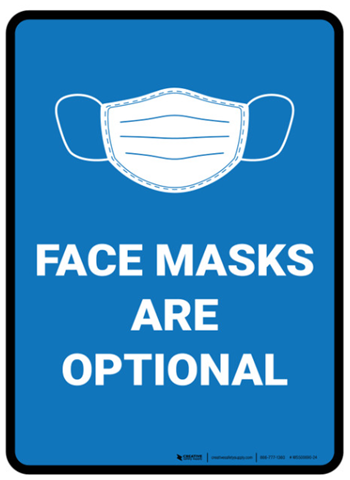 |
Last week In-N-Out Burger announced new employee guidelines for Arizona, Colorado, Nevada, Texas and Utah. Unless an employee has a doctor’s note approving, employees are now banned from wearing a mask. The justification in the company memo was “the importance of customer service and the ability to show our associates’ smiles and other facial features while considering the health and well-being of all individuals.” So, starting August 14th if you’re in an In-N-Out none of their employees will be allowed to wear a mask unless they have a doctor’s permission. If they have a cold, are sneezing from allergies, or just want to be safe in their multiple interactions with the public, they can’t wear a mask.
Thanks to Doc Porter for showing the example of mask wearing while in a public space. It’s too bad the workers at In-N-Out won’t be allowed to share in that starting mid-August.
Music Nights
Thanks to the many Sam Hughes neighbors who came by the Flora’s wine tasting event last Thursday to sit and share in some music and talk. I think Nate and his team at Flora’s could do live music more often than they do – the setting is perfect, and the acoustics are good. For now, they do it the 3rd Thursdays of each month.
On a larger scale is the Union Public House – St. Phillips Plaza outdoor music. I can promise you that the people under the misters in the seating areas were a bit less toasty than I was. But Grant and his team do a great job welcoming people from all over the community. I know we had foothills guests, east siders, people from central Tucson in Wards 3 and 6 all at the plaza for food, drinks, chatter and music.
They’ve invited me back on Sunday, August 13th from 6pm until 9pm. It’d be great to see you there.
Gun Safety
According to a study done by the Journal of the American Medical Association (JAMA) if this little guy was watching a 1-minute video on gun safety, it could save his life, and the lives of others around him.
Last week the Washington Post had an article summarizing a JAMA study in which they wanted to see whether or not watching a gun safety video would affect kids’ behaviors around guns. Why do they care? Because firearms are the leading cause of death for U.S. kids under the age of 17.
In the JAMA study they took 226 kids with ages ranging from 8-12 and randomly had them watch either a one-minute gun safety video or a one-minute car safety video. A week later they were paired up and shown a PG-rated 20-minute video that contained violence – some with guns and some without. Then the kids were left alone in a room and told they could play with anything in it. The researchers had hidden 2 9mm pistols in a drawer, both unloaded but both with a sensor that counted the number of times the trigger was pulled enough to have discharged the weapon.
Those of you with kids this age might not find this surprising, but in the 20 minutes the kids were left alone, 95% of them found the guns (216.) Of those, 34% of the kids who had seen the gun safety video told an adult they had found the guns. Only 11% of those who had not seen the video told an adult. Over half of the kids ended up handling the guns. What was important though is that only 9% of the kids who saw the gun safety video pulled the trigger. Thirty percent of the kids who had not seen the video pulled the trigger. And of the 1,222 times the trigger was pulled in 34% of those pulls the gun was pointed at either the kid holding the gun, or at someone else in the room.
Note to our school districts – until the state legislature outlaws it, show gun safety videos in your classrooms where pre-teens are watching. Show them often. Many kids are visual learners. Simply doing that could save some lives.
Here’s a link to the full article:
https://www.washingtonpost.com/wellness/2023/07/23/children-guns-safety-video/
Refugee Donations
A while back we helped a UA College of Nursing group collect hygiene products they were going to package up and work with our housing protocol team to distribute to homeless people in the community. You – predictably! - stepped up and helped with donations. We’re working with that nursing group again, this time collecting reusable water bottles and umbrellas. The umbrellas you donate do not need to be new – but please only bring new reusable water bottles.
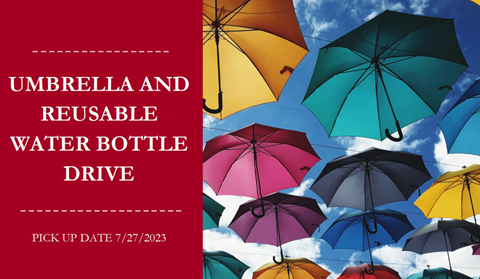 |
The collection effort is taking place throughout this week. We have a collection box out in the front entryway at the ward 6 office. This time the target group to receive your donations will be the refugee community. The nurses are working with Iskashitaa Refugee Network to get the donations out to where they’re needed. We work with Iskashitaa quite a bit here at the ward office so we can vouch for the group as being an effective conduit. The office is open daily until 1pm so please stop in and drop what you’ve got in the box up in the front entry area and we’ll get it to the nurses at the end of the week.
 |
|
Iskashitaa might also be of help to those of you concerned with rats and mice hanging out around your home. One of the most popular community connectors Iskashitaa has is its fruit gleaning program. If you’ve got fruit trees and would like to donate some of the harvest to the refugee community, just contact Iskashitaa and they’ll come out and do the gleaning for you. |
They use the fruit for creating many indigenous dishes – and just to eat straight from the tree. Even up in the tree some rodents will climb and enjoy the fruits of their labor by munching on yours. You can reach Iskashitaa at 520.440.0100, or email them at information@iskashitaa.org.
Here’s a photo of the bottled water many of you brought by last week. Thank you. The 16 cases we delivered to Casa Alitas was very much appreciated. What you see in the truck bed represents about a 1-day supply out at the Welcome Center.
We’re grateful to all of you who took part in this donation effort. We’ll be repeating it every other Tuesday right in front of the ward 6 office. Given the extreme heat, we’ll begin that 2-week rotation tomorrow. Stop on by and drop your water bottles in the truck you’ll see parked out in front. Thank you for helping in this effort.
And finally, on the homeless/refugee donation topic, I’m sharing this part of an email I received last week just to keep it fresh on people's minds that we’ve still got thousands of Afghan refugees – and others – caught up in an asylum system that is fundamentally broken and simply isn’t working for people being persecuted all over the world. I get emails like this regularly. I’ve redacted a couple of names for privacy purposes. You can see that it was sent to our state department contact who is supposed to be working on getting Afghans out of harm's way. The sad reality though is that nobody is getting a response, much less getting out of Kabul.
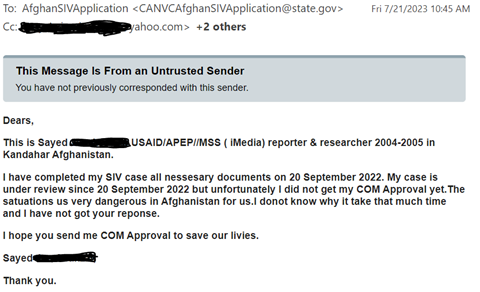 |
The person sending me this email worked as a reporter in Afghanistan prior to our exit. That puts her in immediate jeopardy since Taliban are murdering former journalists. I wish this email was unique, but sadly it’s not. I sent the US SIV application folks a follow up email saying if they’re no longer processing applications then quit stringing Sayed and others along and just tell them they’re on their own. If they are processing applications, then do it. Here is the instant auto-reply:
Sayed’s case has been fully submitted and just waiting for a review since September of last year. If that’s ‘as quick as’ they can do a review then, we own the lives lost in Afghanistan to Taliban while these people wait on our broken congress and broken process.
Housing Affordability
During our study session on affordable housing last week, I put on the table several examples of where we might want to explore some code changes that would facilitate adding housing stock. Some of those included how we accommodate some tiny home village concepts in R2 and/or R3, whether the units be lived in, for purchase, for rent and/or with or without shared community support such as shared laundry/shower/restroom/kitchen facilities. We need to better understand how our current codes are impacting the ability for builders and non-profits to even introduce tiny home/small home products into the market.
Some examples of how our current codes may stifle development include excessive fees associated with tiny home permitting, over-parked site design, how we handle different kinds of product (site built vs modular vs how we can use mobile home pads,) when we require commercially zoned lots vs residential, what site criteria drive designating a development as a ‘condominium’ project, and what we might be able to do locally to step into roles now played at the state level. There are a lot of moving parts to what we’re looking at, but other jurisdictions facing the same challenges are figuring it out. There’s no reason we can’t also.
Portland is building its largest homeless ‘shelter’, starting with 140 sleeping pods along with space for about 20 tents on raised wooden platforms. The tents are to house people who may not be comfortable sleeping indoors. We have them in the Tucson homeless community too. That’s just one of the reasons I’ve long been advocating for controlled/structured camps. Not everybody is ready for one of the rooms we’re providing through Housing First. Let’s not try to force feed our ‘solutions’ on others.
Here’s an image of one of the Portland pods – it's a sleeping quarter. The site contains shared bathrooms, showers, laundry facilities, and it even has a dog run. One of the impediments to many of shelter operations is they don’t allow pets. Many of our homeless population have a pet companion they’re unwilling to part with. Several of the Portland pods and bathrooms are ADA-accessible.
The ByPad sitting outside the ward 6 office would easily substitute for the Portland pod. Recognizing non-traditional building materials is another example of code issues we need to address in our housing affordability conversation.
The Portland pod village is being managed by Feed the Mass – a local non-profit that will provide at least one warm meal per day. We have local non-profits that can provide those same services. The Portland facility is being funded by the state, county and there are local dollars. We can do the same. Here’s a link to an article published by Portland public broadcasting:
Another example of affordable housing that we need to accommodate in our land and building codes comes right from the illegal Ducey border wall. You remember this taxpayer funded mess that is now being dismantled – also at taxpayer expense, thank you Doug – along our southern border.
Those shipping containers were largely one-way containers so many had only been used for one trip to the U.S., and then left without a home. There are cities and companies buying them right now (I’m told the city has put in a bid) and there are designs in place to turn them into affordable houses. This is a picture of one site on which a local company is staging their shipping container product until their production facility – and our codes – are ready for the product. There is certainly a ready market.
Here’s a middle school in Oak Park, California made from shipping containers. There are 3 recycled containers, each 8’ x 40’ combined to make a 940 sq/ft learning space.
This is a village of small commercial spaces, also made from containers. It’s a combined 1,900 sq/ft retail space.
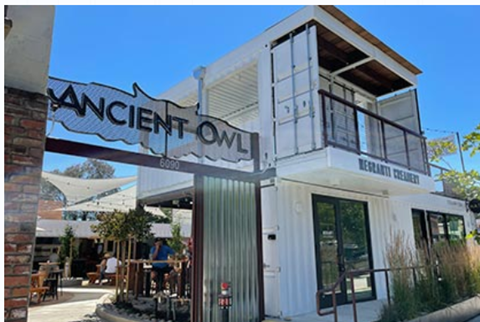 And this is a 3 story, 132-unit facility of transitional housing for the homeless. Each unit is roughly 160 square feet.
Local floor plans I’ve seen are for 320 square foot units – all self-contained with cooking and shower/bathroom facilities. Here’s just one example of a possible floor plan.
Circling back to the code issues – we need to make some changes in both our zoning and our building codes to allow for some of this affordable housing. The narrative in the run-up to the Accessible Dwelling Unit (ADU) code change was they’d be a part of solving our lack of affordable housing. There’s nothing inherently ‘affordable’ about and ADU other than it’s smaller. Building materials, cost of labor and land – none of that changes just because it’s an ADU. But some of the examples I’m sharing here will in fact yield housing options that people can afford. We just need to build some flexibility into our codes so what’s going on in other jurisdictions can begin to happen in Tucson and Pima County.
Tucson Plastic Program
This week's plastic program update is going to mainly be more urging that you use less of it where you can in your daily life. The program is far from running short of the stuff. Your faithful donations are way ahead of our ability to process it and turn it into blocks. Those plans are moving ahead and I’m hopeful that by next week I’ll have some solid information on site location and some product our partners will be making available.
For this week though a big thanks to Laura from Rincon Heights for sending me/us some reusable bags that we’ll be using for our trips across the street to Walgreen’s. As you can see, they’re already being put to use.
The bags fold up into little carrying cases that are only about 4” tall and that weigh probably a couple of ounces. You can order them online. Ward 6 is grateful to Laura for upping our own game here in the office.
And the Reid Park Zoo is still in 8th place in the national ecochallenge that’s aimed at all of us finding ways to reduce the use of plastic in our lives. The contest runs through the end of the month. Use this link to sign up if you haven’t already. https://plasticfree.ecochallenge.org/teams/reid-park-zoo
We’re within reach of passing the Starbucks team that’s right ahead of Tucson in the standings. There are now 223 teams signed up. The Maryland Zoo is way ahead, but it’d be fun to inch past the coffee guys this week.
The ecochallenge contest identifies ways you can reduce the use of plastic in a variety of ways. There’s too much of it in our kitchens, bathrooms, bedrooms, and when we go out to eat. So much of the waste we produce is simply out of lifestyle habits that can be adjusted for the good of the environment.
The weekly total of donations for all 3 locations is still in the 4-ton range. That’s a pretty amazing figure when you consider this is simply material we use as consumers. In Europe there are 18 countries that have bans in place for thin, single use plastic bags. The Arizona state legislature won’t allow local jurisdictions to impose those bans. And there are 23 countries that require consumers to pay a fee for using single use bags. Last week, I shared an ABC survey that showed the bags we return to grocery stores assuming they’ll end up being recycled are mostly still ending up in the landfill. We’ll take them here as a part of our program.
New Tenants at the Zoo
And with the Reid Park Zoo in mind, they announced some new tiny tenants this week. These guys are blue Duikers (Dye-kers phonetically.) They’re little members of the antelope family that are native to much of Africa. Our zoo is getting them as a part of a breeding program that has been recommended under a Species Survival Plan.
The zoo got a male and a female last week. Marigold is the little girl – 10 months old. Viazi is the 2-year-old guy. When fully grown they’ll only be about a foot tall and weigh under 10 pounds. If I saw any during my safari through Africa, I don’t remember them. Lots of other animals, but these little guys can stay pretty secluded.
Fun fact for you to wow your friends with when you visit the zoo – Duikers spend their day eating so much fruit that they’re one of just a few species that can survive without water. You’ve got the best chances of seeing them out foraging between 8am and 10:30am.
Parks Upgrades
We’re making some real good headway in renovating many of our parks throughout the city. Prop 407 was the funding you approved a few years ago for ‘parks and connectivity.’ It’s paying off now.
This is an example of some shade structures that are going in at Linden, Harriet Johnson and Swanway Parks, all in ward 6. Here at the ward office, we want to express our thanks to Tom Fisher for his hard work as project manager on these and other parks-related projects. Tom is retiring this month. He’s an asset to the community and as you can see, he’s leaving behind plenty of completed work that will bring joy to people of all ages for years to come.
Tucson Water
From time to time, I write about the many Tucson Water rebate opportunities we offer. This item is a chance for Tucsonans to brag on ourselves for a moment for the great job we’re doing in the area of water conservation. And it’s a chance to take a fresh look at the rebates that are available to see if there are areas in your life you can benefit from some cost savings that will yield even greater levels of conservation.
The acronym GPCD stands for gallons per capita per day. It’s how much water on average each person in the community uses. As a community we are using about the same total amount of water as we did in the mid-1980's. Our population has increased by over 75,000 residents and Tucson Water has more than 200,000 new service connections since then. Tucson is a leader in conserving that precious resource.
The green line in this graph shows how residential water use has changed since the year 2000. The average household uses roughly 75 gallons of water per day. That’s for showers, washing dishes and clothes, toilets, irrigation – whenever you turn on the tap it hits this graph. I remember as a little kid growing up in Michigan being schooled to avoid letting the water run while brushing your teeth. It’s just one ingrained habit that I have to believe (hope) is universal today.
What areas of our daily living are consuming the majority of the water we use in and around our homes? Irrigation and flushing the toilet make up 2/3 of the residential water use. We have incentives at Tucson Water that can directly impact both of those use categories.
If you use this link, you’ll see the many rebate opportunities you can access for water savings. Some you’ll see are for low-flow toilets and rainwater harvesting systems. That’s the 2/3 water use shown in the pie chart.
You’ll also see rebates for grey water systems, low-income free toilet installation programs, emergency repair plumbing programs, clothes washer rebates, and the water harvesting options for saving on irrigation.
As a community we do really well in conserving water. The monsoon rains are nice. But you know about the drought and the challenges to the Colorado River. Thanks to all of you who are already doing a great job conserving water. It’s in our Tucson DNA. Take a moment to check the website. You might get ideas about ways you can do a bit more.
Sustainable Tucson – Resilient Neighborhoods
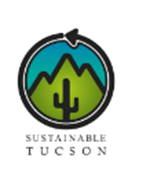 |
|
Our ward 6 friends at Sustainable Tucson are continuing their work on building resiliency into our neighborhoods. One thing we see in every news report of a natural disaster is neighbors stepping up and helping each other through it. That’s the focus of the Sustainable Tucson Building A Resilient Neighborhood (BARN) program. |
TEP is staying ahead of the extreme heat challenges their grid is experiencing. But we could see brown outs if demand outpaces their supply. Monsoons always result in down power lines and loss of power. Those are just 2 examples of where knowing your neighbor and keeping an eye out for each other is important.
Sustainable Tucson is hosting a 1 hour long informational Zoom session that’s going to be focused on connectivity, and resiliency through connection with others. They’ll also bring information on the kinds of supplies you should consider having on hand, cooling methods, ways to communicate and more. They’re offering 3 separate sessions, each an hour long presentation, and each containing the same material. So choose which best fits your schedule:
Sincerely,

Steve Kozachik
Council Member, Ward 6
ward6@tucsonaz.gov

City of Tucson Resources
|